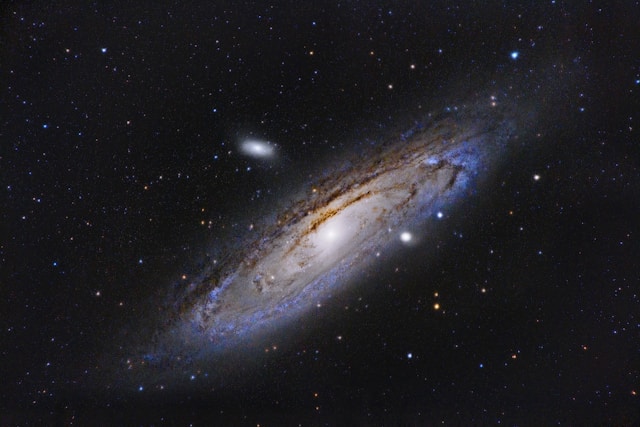JWST captures images of early galaxy formation, revealing processes 400 to 600 million years after the Big Bang
Scientists have identified the formation processes of some of the Universe’s earliest galaxies during the Cosmic Dawn. The James Webb Space Telescope (JWST) has observed the early Universe, around 13.3 to 13.4 billion years ago, revealing signs of gas reservoirs being actively absorbed into three newly forming galaxies.
“You could say these are the first ‘direct’ images of galaxy formation we’ve ever seen,” said Kasper Elm Heintz from the Niels Bohr Institute in Denmark, who led the research. “Whereas the James Webb [Space Telescope] has previously shown us early galaxies at later stages of evolution, here we witness their very birth, and thus, the construction of the first star systems in the Universe.”
Embed from Getty ImagesThe Cosmic Dawn, the first billion years after the Big Bang, remains shrouded in mystery and a fog of neutral hydrogen that blocked light propagation. This fog, composed of neutral hydrogen, obscured early structures. JWST was designed to penetrate this fog with its infrared capabilities, allowing it to capture light from the earliest galaxies.
Heintz and his international team utilized JWST’s infrared capabilities to peer towards the Cosmic Dawn. They detected signals from three galaxies, emanating from the neutral hydrogen surrounding them as the gas absorbed and reemitted the galaxies’ light. These galaxies existed around 400 to 600 million years after the Big Bang, making them some of the earliest detected.
“These galaxies are like sparkling islands in a sea of otherwise neutral, opaque gas,” Heintz explained. The researchers distinguished the gas reservoirs around the galaxies from the intergalactic neutral gas. These reservoirs were substantial, covering large proportions of each galaxy, suggesting active formation into galactic material. The abundance of gas indicated that the galaxies had yet to form most of their stars.
“During the few hundred million years after the Big Bang, the first stars formed, before stars and gas began to coalesce into galaxies,” said cosmologist Darach Watson of the Niels Bohr Institute. “This is the process that we see the beginning of in our observations.”
Despite these findings, many questions about the Cosmic Dawn remain. Scientists have only scratched the surface, with many secrets still hidden within neutral hydrogen. However, the discovery of these three galaxies marks a significant step forward. With the galaxies identified, researchers can now study them more closely to better understand the galaxy formation process.
“One of the most fundamental questions that humans have always asked is: ‘Where do we come from?'” said astronomer Gabriel Brammer of the Niels Bohr Institute. “Here, we piece together a bit more of the answer by shedding light on the moment that some of the Universe’s first structures were created. It is a process that we’ll investigate further, until hopefully, we are able to fit even more pieces of the puzzle together.”
The research has been published in the journal Science.
Analysis
The discovery of the first galaxies during the Cosmic Dawn provides profound insights into the early Universe. Politically, such discoveries often spur international collaboration and funding for space exploration. The JWST, a product of cooperation between NASA, ESA, and CSA, exemplifies the global effort to unlock cosmic mysteries. These findings could encourage further investments in astronomical research and technological advancements.
Economically, the development and maintenance of advanced telescopes like JWST require substantial funding. However, the benefits, including technological innovations and educational advancements, justify these investments. Discoveries about the Universe’s origins can inspire future generations of scientists and engineers, contributing to long-term economic growth.
Sociologically, understanding the Universe’s early stages addresses humanity’s fundamental questions about existence and origins. These discoveries can foster a sense of unity and curiosity, transcending cultural and geographical boundaries. Public interest in space exploration often leads to increased support for scientific research and education.
From a local perspective, communities worldwide benefit from such discoveries through educational programs and public engagement initiatives. Local schools and universities can incorporate these findings into their curricula, inspiring students to pursue careers in science and technology. Additionally, public lectures and exhibitions about the JWST’s discoveries can enhance community knowledge and appreciation for astronomy.
Gender and race considerations in scientific research emphasize the importance of diversity and inclusion. The field of astronomy, like many other scientific disciplines, must strive for equal representation and opportunities for all individuals. Encouraging diverse participation in space exploration ensures a wide range of perspectives and ideas, enriching the scientific community.
Theoretical perspectives on the Cosmic Dawn highlight the intersection of various scientific disciplines. Astronomy, physics, and cosmology converge to unravel the mysteries of the early Universe. These discoveries challenge existing theories and prompt the development of new models to explain cosmic phenomena. The interdisciplinary nature of this research fosters collaboration and innovation across scientific fields.
In conclusion, the identification of galaxy formation processes during the Cosmic Dawn marks a significant milestone in our understanding of the Universe. The political, economic, and sociological implications of such discoveries underscore the importance of continued investment in space exploration. By addressing fundamental questions about our origins, these findings inspire curiosity and drive scientific progress.
